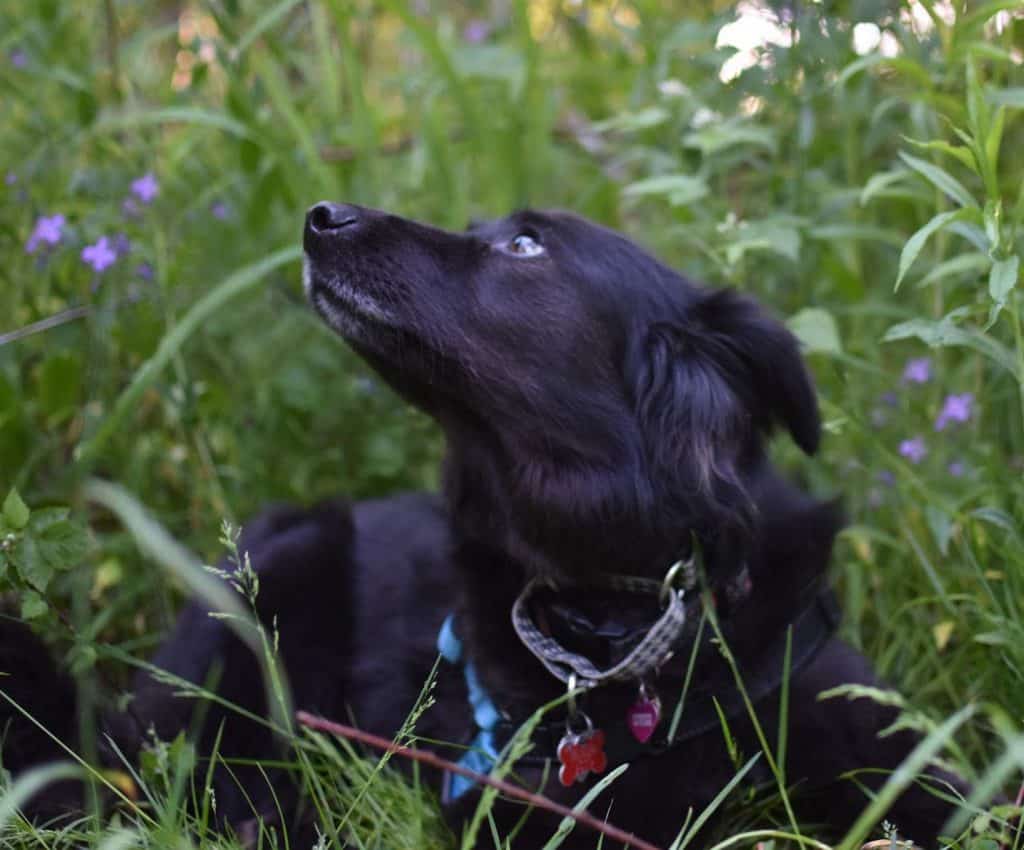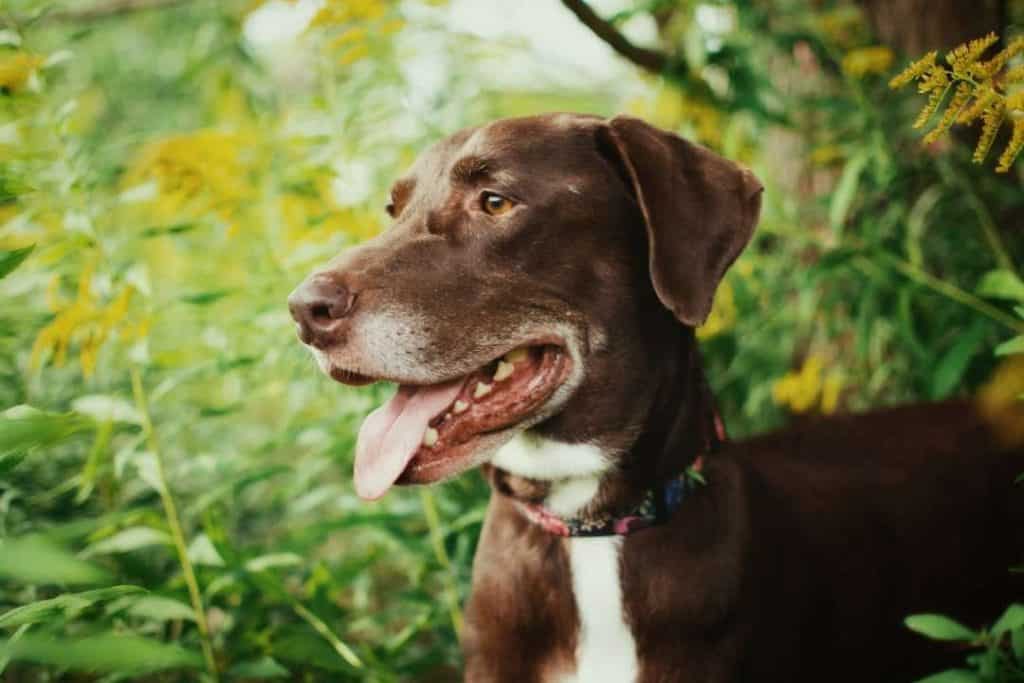- This post contains affiliate links. Read more here.
- This article has been reviewed by a pet health professional. It is not a substitute for professional veterinary advice.
As curious as dogs can be exploring the outdoors, they actually don’t get stung by bees as often as you may think. But when they do, it can be scary, painful, and even dangerous, depending on how your dog reacts.
If you’re wondering what you should do if your dog has an unwanted encounter with a bee, we’re here to help. Learn how to identify the symptoms of a bee sting, treatments you can do at home, and when you need to call your veterinarian.
-
Jessa in purple flowers. Courtesy of Madeleine Sanger Photography
How to Keep Your Dog Safe and Prevent Bee Stings
Your dog is most likely to encounter bees during the spring and summer, when bees are busy collecting pollen and nectar from seasonal flowers.
This doesn’t mean that you need to avoid being outdoors, however. There are many things you can do to decrease the likelihood of a bee sting in the first place.
A quick scan of the area can mean the difference between getting stung and not. It’s essential to practice bee safety whether you’re spending the day at home or heading out on an adventure. Prevention is key, so we’ve compiled a list of the best ways to avoid bee stings altogether.
- Keep your dog away from bee hives. A buzzing, sweet-smelling hive may be fascinating to a dog who is a curious creature by nature.
- Avoid heavily flowered areas. Bees are drawn to flowers, so it’s best to skip blooming areas as much as possible.
- Wear light-colored clothing when hiking. Bees see darker colors as a threat.
- Keep your dog on a leash. When out for a walk or hiking the trails, it’s best to keep your dog on a leash to prevent them from accidentally stumbling upon a colony.
- Spend time outside when bees are least active. This includes early morning and after dark.
- Use vinegar diluted with water as a natural repellent. The Vinegar Institute recommends using one cup of white distilled vinegar to two gallons of water to eliminate odors on smelly dogs. As an added bonus, bees dislike the sour aroma.
- Apply canine-specific bug spray. While it’s unsafe to use human bug spray on your dog, there are bug sprays specially formulated to be safe for dogs.
-
Kenai running in a field of flowers. Courtesy of Madeleine Sanger Photography
Signs Your Dog has Been Stung by a Bee
If you suspect a bee has stung your dog, the first thing to do is check for a stinger, although you may not be able to find it. If the sting happens in a really furry area on your dog’s body, there may be no apparent indicators.
Other times, your dog may yelp, favor the area, paw at their face or muzzle, limp, or even bite at the sting. If you can see it under all that fur, most bee stings look like small, red, swollen areas. They may be warm to the touch and are often painful to the pet.
Some swelling and discomfort is normal, and does not necessarily indicate an allergic reaction.
What to Do if Your Dog Gets Stung by a Bee
Sometimes, bee stings are inevitable. That’s why it’s important to know how to proceed. You will need to determine if the sting is mild enough to be treated at home, or if your dog requires a trip to the vet.
What’s an emergency—and what’s not
A trip to the vet is warranted for the following non-emergent reasons.
- If a bee stings your dog on the nose, near the eye, in the ear, in the mouth, or close to the rectum. You’ll want your veterinarian to check that everything is OK.
- Multiple stings. More than one sting could cause your dog to have a more severe allergic reaction as there will be more venom in their system.
Some dogs are very allergic to bee stings, and just one sting can trigger a reaction. Allergic reactions usually occur within 20 minutes of the sting but may be delayed, so close monitoring is critical. Severe reactions, including anaphylaxis, can be fatal, so you must act quickly.
Symptoms can range from mild to severe, so it’s important to know what to be on the lookout for and how to handle each one.
Symptoms of a mild reaction
Some dogs have a very mild reaction. You can likely treat these at home. The symptoms occur at the site of the sting and the area may be:
- Swollen
- Warm to the touch
- Red
- Itchy
- Painful
Symptoms of a moderate reaction
Other dogs may react a bit more seriously. This type of reaction requires a call to your veterinarian, close monitoring, and extra care, but usually doesn’t involve a trip to the vet. A moderate reaction can include:
- Continued swelling that may spread
- Loss of appetite
- Lethargy
Symptoms of a severe reaction
A severe reaction is more likely if your dog has a bee allergy or suffers multiple stings. (Like if they encounter a hive rather than just one bee.)
If your dog has a severe reaction, they require immediate medical attention as their symptoms can be life-threatening. Take your dog to their regular veterinarian or to an emergency clinic if it’s after hours. A severe reaction can include:
- Swelling around the head and neck that make breathing difficult
- Trouble breathing or wheezing, potentially caused by swelling of the airway
- Excessive drooling indicating that your dog’s throat is swelling and they are having trouble swallowing
- Agitation as the result of pain, itching, or trouble breathing
- Vomiting or diarrhea
- Dizziness or disorientation, a sign your dog may be having a potentially dangerous reaction
- Seizures
- Hives anywhere on the body
-
Sweetie in yellow flowers. Courtesy of Madeleine Sanger Photography
What Happens Now?
Once you’ve determined whether or not your dog will need to see the vet, here’s what you can expect.
At the vet
If it’s necessary to take your dog to the vet, you can expect quick action. The team may even whisk your dog in the back to begin treatment if your dog is having trouble breathing.
Your veterinarian will perform a thorough examination that will likely begin with a prophylactic Benadryl injection. Once your dog is stable, the medical staff will administer IV fluids and steroids. Your veterinarian may recommend an overnight stay and careful monitoring until your dog fully recovers.
At home
If you don’t need to head to the vet, there are several things that you can do at home to help your dog stay comfortable and reduce the pain and swelling that often accompanies a bee sting. Experts at VCA Animal Hospitals recommend the following:
- Find and remove the stinger. Scraping a credit card over the area is the best way to do this. Tweezers can actually make things worse by squeezing extra venom into the sting.
- Soothe the sting. Apply a thick paste of baking soda and water to the site of the sting.
- Minimize swelling. Applying an ice pack to the area to reduce swelling and relieve discomfort and pain.
- Consult your veterinarian. An oral antihistamine can minimize the reaction and decrease itching, but make sure to talk to your veterinarian first.
- Prevent your dog from scratching the area. Scratching the sting can make matters worse by delaying healing and causing infection.
- Give your dog fresh water and small amounts of food. You may need to moisten their dry food to make it easier for them to eat.
Never give your dog medication at home without your veterinarian’s approval.
Keep these things on hand in case of bee stings
- Baking soda
- Oatmeal. An oatmeal bath may help if your dog has multiple stings. Add one cup of plain oatmeal ground into a powder to a tub of lukewarm water and let your dog soak for ten minutes before thoroughly rinsing them off.
- Benadryl. Remember to always consult your veterinarian before giving any medications.
- An EpiPen. It’s not safe to use a human EpiPen on your dog, but your veterinarian may prescribe one that’s veterinarian approved if your dog is allergic to insect bites and stings. You can carry it with you when your dog is outside just to be safe.
Bee Careful Out There
Bees are docile creatures who only sting if they feel threatened. Nevertheless, stings happen. If your dog does happen to meet the stinger of a bee, there’s no need to panic. Call your veterinarian, watch for any signs of an allergic reaction, and keep your dog comfortable. After all, the great outdoors is a beeautiful place for us all to soak up the sunshine.





